You will be met at the airport by our representative and introduced to your chauffeur guide who will be accompanying you on your tour. The guide will remain with you until your beach stay unless we have advised you otherwise.



Kite Surfing in Sri Lanka is for most part in the North West of the country approximately 150 km north of Colombo Airport. The peninsula with its main town called Kalpitiya stretches for about 50 kilometers from top to bottom and encloses the big Puttalam Lagoon. Apart from these popular kite spots in Kalpitiya peninsula and Puttalam, there are some other kite spots in Sri Lanka. Chillaw, and Negombo located south of Puttalam are also two main kite spots in Sri Lanka. Mannar Island is also gaining its reputation as an excellent kite spots in Sri Lanka recently.
Most kite surfing resorts in the North West region are located either on the bigger Kalpitiya Lagoon or on the smaller Kappalady Lagoon (see below). Puttalam Lagoon is also another popular kite spot in Sri Lanka and popular for kite trips and kite safaris.
Kappalady Lagoon, although smaller compared to other kite locations is one of the best kite spots in Sri Lanka where the wind blows consistently throughout the year.



Kite Surfing
Morning Jeep Safari – Wilpattu National Park
The park is situated along the Northwest coast lowland dry zone of Sri Lanka. It comprises of a unique complex of lakes called Villus, which are natural basins that are filled up with rainwater and are surrounded by open grassy plains set within dense scrub jungle. A multitude of sandy paths wind around the entire park and open up into these large natural lakes. The unspoiled and beautiful Wilpattu National Park is one of the largest and oldest National Parks in Sri Lanka. It is ideal for those wanting to escape the flurry of activity of Yala and instead offers the opportunity for a tranquil, peaceful and undisturbed drive.
The biggest draws in Wilpattu are Leopards and Sloth bears. Alongside these, it is possible to see Asian Elephants, Spotted Deer, Barking Deer, Wild Pig, Asiatic Buffalo and Mugger Crocodiles. Endemic birds include the Ceylon Junglefowl, Brown-capped Babbler, Ceylon Woodshrike and Black-capped Bulbul in riverine habitats. Muntjac or Barking Deer are more easily seen in Wilpattu than any other national park. Butterflies recorded include the Great Eggfly, Great Orange Tip, Glad-eye Bushbrown, Blue Mormon, Common Mormon, Common Rose and Crimson Rose.



Morning
Morning Jeep Safari – Wilpattu National Park
Horse Riding Around Kalpitiya and on Beach.
Horse riding is one of the oldest types of games in Sri Lanka that requires much patience, balance in training. It is a standout amongst the most intuitive games as guaranteed by the individuals who cherish it. It is an aptitude created with time to ride, drive, steeplechase or vault with horses. This little island offers stunning sights and experiences.
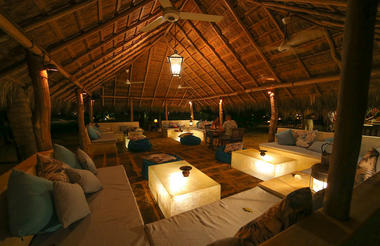
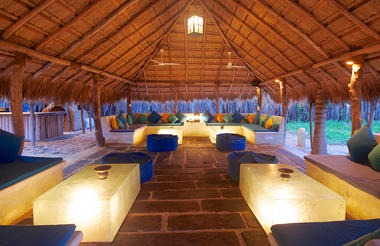
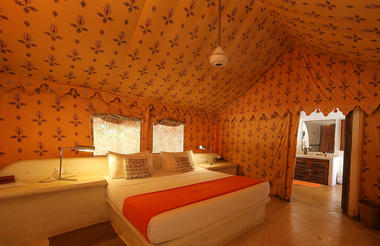
Morning
Horse Riding
Cycling around Anuradhapura
Anuradhapura was the first capital and undoubtedly the grandest city of the ancient Sri Lanka, It is the home of two World Heritage sites. Many places of historical and archaeological interest are found here. However, given the one and half to two hour journey to reach Anuradhapura from most of the hotels in the Sigiriya district and the scale of the ancient city, we recommend a full day is allocated to this attraction and visitors who are restricted on time normally chose not to visit Anuradhapura. Sri Maha Bodhi, the sacred bo-tree, was brought as a sapling of the tree under which prince Siddhartha attained to enlightenment and it is over 2,300 years old and is said to be the oldest historically documented tree in the world. At Brazen Palace, (2nd century B.C), the 1600 stone columns you see are all that is left of a magnificent multi-storied residence for monks. Ruwanweliseya (2nd century B.C) is the most famous of all the Dagobas.
It originally depicted the perfect 'bubble shape' that modern restoration has not been able to accurately reproduce. The Samadhi' Buddha statue (4th century AD) is one of the most famous statues, depicting the Buddha in a state of 'Samadhi' or deep meditation. Isurumuniya rock temple (3rd century B.C) is well known for its rock carvings of 'The Lovers'. Kuttam Pokuna – twin ponds (6th century AD) was used by the Buddhist monks as a bathing pool. Thuparama Dagoba (3rd century B.C) is the oldest Dagoba in the island, which enshrines the right collarbone of the Buddha. Close by, some 30 minutes by car, in Mihintale, is the site where Buddhism was first introduced to Sri Lanka. Found on this rock are many shrines and dwellings originally used by monks. A grand stairway of 1,840 steps made of 15 feet wide granite slabs leads to the summit from where one can get a splendid view of the surrounding countryside.
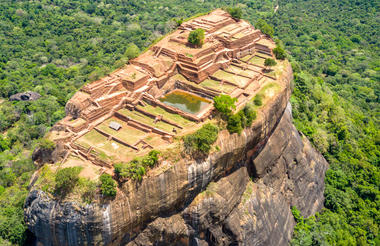
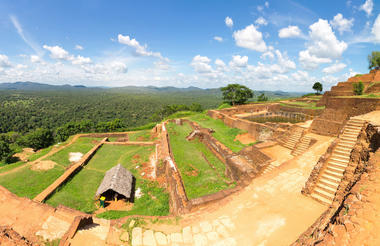
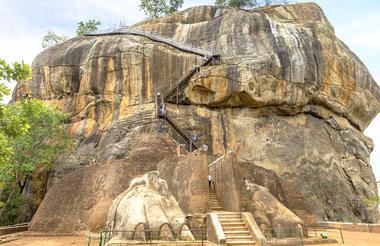
Morning
Cycling around Anuradhapura
Sigiriya Rock Fortress
Sigiriya (Lion Rock) Referred by locals as the Eighth Wonder of the World this ancient palace and fortress complex has significant archaeological importance and attracts thousands of tourists every year. It is probably the most visited tourist destination of Sri Lanka. Sigiriya rock plateau, formed from magma of an extinct volcano, is 200 meters higher than the surrounding jungles. Its view astonishes the visitors with the unique harmony between the nature and human imagination. The fortress complex includes remnants of a ruined palace, surrounded by an extensive network of fortifications, vast gardens, ponds, canals, alleys and fountains. In the 3th century BC the rocky plateau of Sigiriya served as a monastery. In the second half of the 5th century king Kasyapa decided to construct a royal residence here. After his death Sigiriya again became a Buddhist monastery until the 14th century, when it was abandoned. The main entrance is located in the northern side of the rock. It was designed in the form of a huge stone lion, whose feet have survived up to today but the upper parts of the body were destroyed. The western wall of Sigiriya was almost entirely covered by frescoes, created during the reign of Kasyapa. Eighteen frescoes have survived to this day. The frescoes are depicting nude females and are considered to be either the portraits of Kasyapa’s wives and concubines or priestess performing religious rituals. One of the most striking features of Sigiriya is its Mirror wall. For those who are not comfortable with heights or have problems climbing we suggest the gardens of Sigiriya which are amongst the oldest landscaped gardens in the world. They are located in the western part of the rock with bridges, fountains, as well as surface and underground water pumps.
Minneriya National Park - Afternoon Jeep Safari
The Minneriya Tank was created by King Parakarambahu at the height of Polonnaruwa’s glory as the capital of Sri Lanka. The national park based largely around the huge tank (reservoir) was created rather more recently but serves as an important gathering place for Sri Lanka’s large population of elephants. It is a great place for elephant spotting all year round – though as the dry season makes water scarce between June and September, more and more elephants gather on the shores of Minneriya Tank.
Indeed by late August and September, the awe inspiring site of up to 300 elephants can often be seen, in a phenomenon known as ‘The Gathering’. It is the largest concentration and gathering of Asian elephants that can be seen anywhere in the world. Watching baby elephants playing with each other, bull elephants tussling for dominance and the great matriarchs surveying the scene is not a sight you are likely to forget in a hurry. Aside from the elephant, Minneriya is also home to some 23 other species of mammals: some, like the Deer and Sambur you will see, some like the Leopard and the Sloth Bear will probably prove elusive. The arid dry zone is a paradise for many species of Lizard and you will see them here in all their technical colour brilliance if you look carefully enough, as well as snakes like the Indian Python and the Mugger Crocodile. Above all, of course, are Sri Lanka’s wonderfully varied bird population. Among the 150 or so species, particular favorites of ours you may see in Minneriya include the beautiful painted stork, and various other bird species.

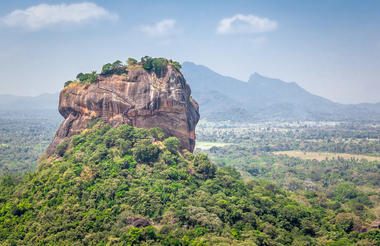
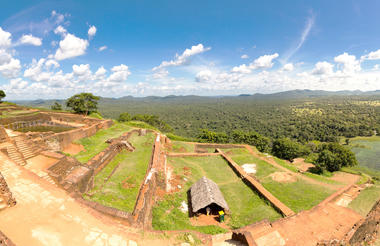
Morning
Sigiriya Rock Fortress
Afternoon
Minneriya National Park - Afternoon Jeep Safari
Dambulla Rock Temple and Cycling Tour
The Dambulla Rock Temple was donated by king Walagambahu in the 1st century BC to Buddhist monks. Dambulla is a World Heritage Site and is the most impressive of Sri Lanka's cave temples. The complex of five caves with over 2000 sq. meters of painted walls and the ceiling is the largest area of cave paintings found in the world. These caves contain over 1500 images of the Buddha of which the largest is the colossal figure of the Buddha carved out of rock spanning 14 meters. Close to the town of Dambulla this attraction is easily accessed although it requires walking up a considerable number of steps to reach the caves from the road. If you are a little short of time, a visit to the Dambulla rock temple can be combined with travelling to or from the Sigiriya area.



Dambulla Rock Temple and Cycling Tour
Polonnaruwa and Transfer to Kuchchaveli.



Snorkeling
Sri Lanka’s famous Pasikuda beach is perched along the eastern coastal line of Batticaloa and stretches for 2 km of beautiful golden sand and sapphire sea. The calm and shallow waters of this gorgeous bay allow you to wade in for up to half a kilometer with no depth or current to fear. It is also home to an incredible collection of marine life, sustained by the delicate coral reef which, together with the crystal clear waters, makes for the perfect conditions for snorkeling.
Explore one of the longest stretches of shallow reef coastline in the world. Learn snorkeling if you are a beginner, and enjoy to maximum if you are a professional or an amateur. Enjoy Sri Lanka’s tropical waters and its colorful reefs and fish. Engage in one of the must-do activities on the Eastern coast



Morning
Snorkeling
Whale & Dolphin Watching
Trincomalee is another spot for Dolphin and whale watching. Trincomalee, located 257KM north-east of Colombo, is one of the finest natural deep water harbors in the world. It is also home for lots of eye capturing beaches where you can explore your favorite marine mammals in their own splendid habitats.
Whale and Dolphin watching has been a most exciting leisure activity in the past few years, in Sri Lanka and still remains the same. The best season for Whale and Dolphin watching in Trincomalee is May to October. During your excursion you will be able to spot various species of Dolphins and Whales, for instance Bottlenose Dolphin, Spinner Dolphin, Fraser’s Dolphin, Blue Whale, Killer Whale, Bryde’s whale and many more. During this season the ocean remains in tranquil, providing the most perfect surrounding to watch Whales and Dolphins in a closer proximity.
Whale watching boat trip off the coast of Trincomalee will last for 4 to 5 hours. The speed boat leaves the shore of Trincomalee by 6.30 AM. Jump on aboard for a whale watching expedition in Sri Lanka for an exhilarating experience of a lifetime and don’t miss out on one of nature’s biggest wildlife spectacles in the Ocean.



Afternoon
Whale & Dolphin Watching
Day 11: Transfer to Arugam bay.
Day 12 - Day 13: Surfing in Arugam bay
The East Coast season is marked by the end of the North East monsoon in the months leading up to May and lasts till October. In this 6 month period, as the ocean ebbs and flows to its rhythm, the swell from the south and south-east starts shifting sand, beginning the process of reshaping headlands and sand bars for the perfect set up.
Main Point: this is the surf spot actually located in Arugam Bay. Every morning you’ll see dozens of surfers out there catching some quality waves. This is recommended more for intermediate to advanced surfers.
Whiskey Point: About a 15 minute drive from Arugam Bay is this famous surf spot. It’s a really beautiful beach as well, and can provide some excellent waves for beginner surfers. You’ll also notice heaps of people on surfing lessons.
Peanut Farm: About 25 minutes from Arugam Bay is this awesome tucked away beach / surf spot. Very popular, and highly recommend.



Surfing in Arugam bay
Yala National Park - Afternoon Jeep Safari
Located in the wild south-east part of the island, this region is a haven for flora and fauna and excellent game. The beaches are backed by large sand dunes giving rise to lagoons, woodland and scrub bush. The premier wildlife location in Sri Lanka, Yala offers an almost African safari experience as well as an important Buddhist temple site. On game drives by jeep, one can usually view wild elephant, buffalo and boar, huge monitor lizards, macaque monkeys and many rare and endemic bird species: it is also the best place in south Asia to spot the elusive leopard, often seen and admired. Lazing on a treetop, blending in perfectly with its surroundings, the big cat is almost invisible, yet the absence of tigers in Sri Lanka makes for a leopard with real attitude. Usually tagged ‘Prince of the Night’, this cat is well out of its normally nocturnal closet. Confident, it will stroll in the open by day, to every ecotourist’s delight. There are believed to be about 600 leopards across Sri Lanka today, mostly in the protected parks and reserves. Yala National Park has one of the highest recorded densities of leopards in the world, The Sri Lanka Sloth Bear-shaggy, shuffling and rather hunch-backed black bears may be seen loping around even in daylight and are endemic to Sri Lanka. This park is famous for its high density of leopards, perhaps the highest in the world. You are also sure to see elephants – grumpy loan males during the dry months and large herds in the wet season. Sloth bears are also a big draw. You will also see mammal such as wild boars, several species of deer and wild buffalo. There is a plethora of reptilian species and platoons of crocodiles. As is common in Sri Lanka there is a huge diversity of stunning birdlife including migratory species such as the flamingo. It is also one of the few places in the world where the severely endangered black necked stork can still be seen. The uniqueness of the park is the sheer diversity of the habitat: dense jungles suddenly gives way to lagoons and open plain areas and the park has a simply beautiful sea front. Huge, stark boulders dominate the horizon and the elegant, languorous leopard can often be seen basking atop the sun baked rock.
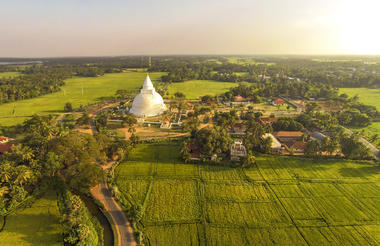

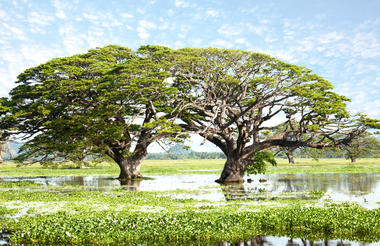
Afternoon
Yala National Park - Afternoon Jeep Safari
Yala National Park Jeep Safari.



Yala National Park Jeep Safari
Full Day Jeep Safari - Udawalawe National Park Safari
The Rusty-spotted Cat, Fishing Cat and Sri Lankan Leopard are members of the Felidae family present in Udawalawe. The Sri Lankan Sloth Bear is seldom seen because of its rarity. Sri Lankan Sambar Deer, Sri Lankan Axis Deer, Indian Muntjac, Sri Lankan Spotted Chevrotain, Wild Boar and Water Buffalo are among other mammal species. Golden Jackal, Asian Palm Civet, Toque Macaque, Tufted Grey Langur and Indian Hare also inhabit the park.
Udawalawe is also a good bird watching site. Endemics such as Sri Lanka Spurfowl, Red-faced Malkoha, Sri Lanka Grey Hornbill, Brown-capped Babbler, and Sri Lanka Jungle fowl are among of the breeding resident birds. White Wagtail and Black-capped Kingfisher are rare migrants. A variety of water birds visit the reservoir, including cormorants, the Spot-billed Pelican, Asian Openbill, Painted Stork, Black-headed Ibis and Eurasian Spoonbill, The open parkland attracts birds of prey such as White-bellied Sea Eagle, Crested Serpent-eagle, Grey-headed Fish Eagle, Booted Eagle, and Changeable Hawk-eagle. Land birds are in abundance, and include Indian Roller, Indian Peafowl, Malabar Pied Hornbill and Pied Cuckoo.



Full Day Jeep Safari - Udawalawe National Park Safari
Transfer to Nine Skies Bungalow.



Little Adam’s Peak & Local Walking Excursion
Ella is a hiking hotspot in the mountain country of Sri Lanka. Some of the views from hikes in Ella are phenomenal with the region well known for its tea plantations and spectacular mountain ranges. If you want to enjoy some of the best views without needing to hike for hours, Little Adam’s Peak is the perfect trek, especially for an unforgettable sunset.
Little Adam’s Peak Trail begins with a moderate incline as it winds through tea plantations. There are some great photo opportunities early on in the hike if you keep your eyes open!
The beginning of the path goes through beautiful lush green tea plantations full of tea picking ladies. 1141 m high, is fairly easy to climb, with a good path all the way up.



Morning
Little Adam’s Peak & Local Walking Excursion
Morning Train ride from Demodara to Kandy.
The train is by far the best way as it snakes through the most glorious scenery, including tea plantations.
The lush green hills are purely breathtaking. The train takes you high into the mountains, through dense forest & vibrant green tea fields, over bridges, through tunnels, local villages and beside smiling faces. If you look closely every so often you’ll notice the colorfully dressed ladies pop their heads up amongst the tea fields as they carry on with their work.
Kandy Temple of the Tooth
Kandy was the last capital of the Sri Lankan kings, and is a World Heritage Site. The name Kandy conjures visions of splendor and magnificence. Many of the legends, traditions and folklore are still lovingly kept alive. Drive around the Kandy Lake built by the last Sinhala king Sri Wickrama Rajasinghe in 1798.
In 1542 the Tooth Relic was brought to the city , stimulating a flurry of new religious building- a two storey for the relic itself and 86 houses for the monks. By 1602 the city had probably taken the form. Kandy was repeatedly attacked by the Portuguese, Dutch and the British and been rebuilt several times.
The area with the Temple of the Tooth and associated buildings, a world heritage site, is the chief focus of interest. The Udmale (upper storey) houses the relic which is caged behind gilded iron bars and a series of 7 seven smaller caskets. Ceremonies start at 0530, 0930 and 1830. These are moment the temple comes to life with pilgrims. One would need to be dressed appropriately for the temple as any other religious building. Kandy is perhaps most famous however for the annual Perahara, a most magnificent site which sees the scared tooth relic take to the streets accompanied by dancers, drummers and most significantly elephants dressed in all their finery and adorned with lights. The parade which goes through the streets of Kandy builds into a spectacular procession over consecutive nights with the number of elephants growing each night. The procession normally takes place annually at the end of July or early August.



Morning
Morning Train ride from Demodara to Kandy
Afternoon
Kandy Temple of the Tooth
Millennium Elephant Foundation houses a number of elephants rescued from various situations, such as aggressive mahouts, or elephants retired from working in temples. Volunteers (for 3 months) are welcome at the foundation and the facility also supports a mobile veterinary service.
This registered charity cares for elderly and disabled elephants. Although it has less of the “aah factor”, it is worth a visit.



Morning
Millennium Elephant Foundation
White water rafting in Kithulgala - One of the most popular destinations for rafting in Sri Lanka is Kithulgala, situated on the road from Colombo to Hatton. Made famous when it was chosen as a prime location in the filming of the 1957 award winning film 'Bridge on the River Kwai.' The Kelani River flows through the Kitulgala's rock strewn sections and the rapids provide ample pleasure for anyone seeking a rafting experience. The actual run takes about 1 ½ hours to 3 hours depending on how much time you want to spend in water, during which you encounter grade 2 and 3 rapids, bearing unique names such as Butter Crunch, Killer Falls, Head Chopper and Virgin's Breast.
The river's clear water tumbles through a rocky gorge just above Kithulgala. As the river widens, the river passes the scenic location used for the film -(“Bridge over the river Kwai”), which is also a great place to jump in for a refreshing swim. For those who would like to enjoy the river and its wonderful scenery without the thrills and spills of large rapids, rafting is possible through the flatter section of the lower gorge, suitable for children over six and family groups.
We recommend that clients check that their insurance is valid for this hazardous activity.



Morning
White water rafting in Kithulgala
Rosyth Cooking Lesson
After a relaxed breakfast, at approximately 10:30 visit the organic kitchen garden with the Chef who, along with the gardener will explain the produce and some of the spices that is grown at Rosyth. On your return to the kitchen, you will have the opportunity to cook authentic Sri Lankan curries. You may be joined by other guests. The maximum number of guests is eight. The menu has been designed to include ingredients which are available in Europe. Your hands-on cooking class will include a fish or chicken curry and three other vegetable curries and a traditional salad. Sit down for lunch in the dining room in the canopy of the trees with the curries that you have cooked and enjoy your lunch with the rice and poppadum's. You will have the opportunity to take away the recipes to replicate at home. The curries: The main curries are Chicken, Fish or Mushroom. Green bean, Lentil and spinach, aubergine & Gotkola sambal. When you sit for lunch we will serve you red or white rice, popadoms and homemade chutneys. You will have the recipes to take home and we suggest you purchase the spices from a supermarket before you fly home.
Walk to the Rosyth Tea Factory (10 minutes) Just a few minutes’ walk from the house is the local tea factory & whilst not part of our estate, guests are welcome to visit the factory and understand how the tea we grow, is turned into fine tea for export. Many concur that Sri Lanka Tea is the best in the world. The tea grown at Rosyth is particularly popular in the Middle East. The old orthodox method of tea processing produces the liquor of the Unbroken Flower Orange Pekoe in its most superior grade. You will have the opportunity to purchase tea at the factory to take home.
A short tour will take through the factory where the fresh leaves are dried by fans on withering troughs to reduce the moisture content and then rolled and pressed to express the juices which coat the leaves. The leaves are then left to ferment in humidity. The final process dries the leaves and then the leaves are graded. Unbroken being the best quality, fannings and the dust which is the quality used in tea bags.
Rosyth Estate Walk
Rosyth is a small working estate. Tea is plucked by hand and sold to the nearby tea factory, whilst latex is tapped, treated and sold to a local rubber factory. Coconuts, fruits, spices and other produce are grown on the estate and are, wherever possible, used as part of our menus.
Guests are free to explore the estate, join the ladies plucking two leaves and a bud from the tea bushes or see how the rubber is tapped. Equally take a walk down to the river and discover the small waterfall or to the local paddy fields and enjoy meeting with the local villagers. The Estate contains walking trails, mountain biking routes and our staff will be happy to guide you through the tea terraces, rubber plantation and paddy fields.



Rosyth All Day Activities
Day 23: Breakfast at the hotel and proceed to the airport for the departure flight to Maldives.
Welcome to the tropical paradise of Maldives! After reaching there, get transferred by a speedboat to your resort and check-in to your room.
Day 24 - Day 28: Spend the day relaxing and admiring the views of crystal clear waters ebbing sandy beach.



Enjoy a hearty breakfast at the hotel and then check-out. A speed boat will await you for your transfer to the airport. Fly back home with wonderful memories of an amazing trip!




